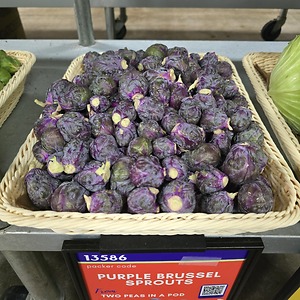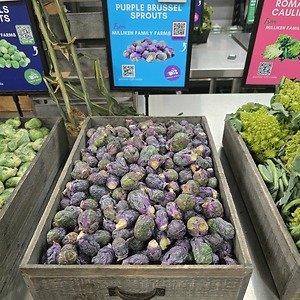


Baby Purple Brussels Sprouts
Estimated Inventory, 12 ct : 0
Description/Taste
Baby Purple Brussels sprouts are small, compact buds, averaging 1 to 2 centimeters in diameter, and have a round to oval shape. The buds consist of multiple layers of tightly packed, textured leaves that are semi-thick, dense, and chewy with a crunchy consistency. Each leaf bears variegated hues of green to dark green and is covered in raised, dark purple to violet, fleshy veining. Baby Purple Brussels sprouts have a subtle fibrous quality when fresh, emitting immediate grassy and earthy flavors, followed by a bittersweet taste that develops into a sweet lingering aftertaste. When cooked, Baby Purple Brussels sprouts continue to mellow in flavor, creating rich vegetal, sweet, and nutty notes.
Seasons/Availability
Baby Purple Brussels sprouts are available in the fall through early spring.
Current Facts
Baby Purple Brussels sprouts, botanically classified as Brassica oleracea, are small, multi-colored buds growing on a thick, upright fibrous stalk belonging to the Brassicaceae family. In the late 20th century, geneticists and breeders sought to transform Brussels sprouts from their bitter reputation and develop new varieties with improved flavor, appearance, and texture. These modern cultivars, including Baby Purple Brussels sprouts, lack the bitterness commonly associated with classic green Brussels sprouts and are cultivated on a small scale as a niche market vegetable. Baby Purple Brussels sprouts are a hybrid variety developed from green Brussels sprouts and red cabbage. The baby variety is smaller, more tender, and sweeter than larger Brussels sprout cultivars and can be used fresh or cooked in a wide array of culinary applications.
Nutritional Value
Baby Purple Brussels sprouts are a good source of vitamin K, a nutrient that assists in faster wound healing for the body, and vitamin C, an antioxidant that strengthens the immune system while reducing inflammation. The sprouts are also a source of fiber to stimulate the digestive tract and provide lower amounts of folate, vitamin A, and vitamin B6. The purple coloring of Baby Purple Brussels sprouts contains anthocyanins, flavonoids that have antioxidant-like properties.
Applications
Baby Purple Brussels sprouts have a sweet, nutty, and earthy flavor well-suited for both raw and cooked applications. The small buds can be thinly sliced or shaved into green salads, mixed into coleslaw, or added into grain bowls for color, texture, and flavor. Baby Purple Brussels sprouts can also be roasted, steamed, braised, boiled, fried, or sauteed. It is important to note that some of the colors may be lost during cooking, turning the Brussels sprouts slightly brown, light purple, or blue, but adding vinegar will help maintain the dark purple vibrancy. Baby Purple Brussels sprouts can be roasted as a filling side dish to cooked meats, sliced and mixed into soups, stirred into pasta, tossed into stir-fries, or baked into creamy casseroles. The sprouts are known for absorbing accompanying flavors and can add texture and sweetness to rich, hearty dishes. Baby Purple Brussels sprouts pair well with meats such as bacon, pork belly, pancetta, beef, poultry, and fish, eggs, potatoes, mushrooms, fruits such as apples, grapefruit, and lemons, nuts such as hazelnuts, chestnuts, almonds, and pecans, maple syrup, vinegar, and herbs such as sage, thyme, dill, and basil. Whole, unwashed Baby Purple Brussels sprouts will keep for 5 to 7 days when stored in the crisper drawer of the refrigerator.
Ethnic/Cultural Info
Since the 1990s, Brussels sprouts have gone through many years of breeding and rebranding in an effort to change the vegetable’s odorous and bitter reputation. Many new varieties were created in Belgium in the 1940s, including Baby Purple Brussels sprouts, and the modern cultivars were bred without the chemical compounds that produced the bitter flavor commonly associated with the classic green sprouts. Once released to commercial markets, the improved cultivars were planted by select growers and promoted through farmer’s markets as novel varieties. The image of Brussels sprouts was also altered through the promotion of celebrity chefs. The sprouts were incorporated into modern, aesthetically beautiful applications, which inspired other restaurants to reinvent how the buds were cooked, creating new appetizers and side dishes. Beyond the sprout’s increasing popularity among trendy restaurants, children learned about the benefits of Brussels sprouts using scientific experiments. In the United Kingdom, the Big Bang UK Young Scientists and Engineers Fair once used over 1,000 Brussels sprouts to power a battery for LED lights on a Christmas tree in Southbank, London in 2013.
Geography/History
Purple Brussels sprouts are descendants of green Brussels sprout varieties native to a region near Brussels, the capital city of Belgium. Green Brussels sprouts were first documented in written texts in Europe during the middle ages, and it wasn’t until the early 1940s that Purple Brussels sprouts were created. Scientist and Dutch plant breeder C.N. Vreeken is credited with developing Purple Brussels sprouts from a cross between a red cabbage variety with green Brussels sprouts. Vreeken created the multi-colored variety in an effort to breed new cultivars with a sweeter flavor. Purple Brussels sprouts were introduced to the United States sometime in the late 20th century and are an unusual cultivar, sold in limited supply through farmer’s markets and specialty grocers. Baby Purple Brussels sprouts are also cultivated on a small scale in Europe and Canada.
Recipe Ideas
Recipes that include Baby Purple Brussels Sprouts. One

















